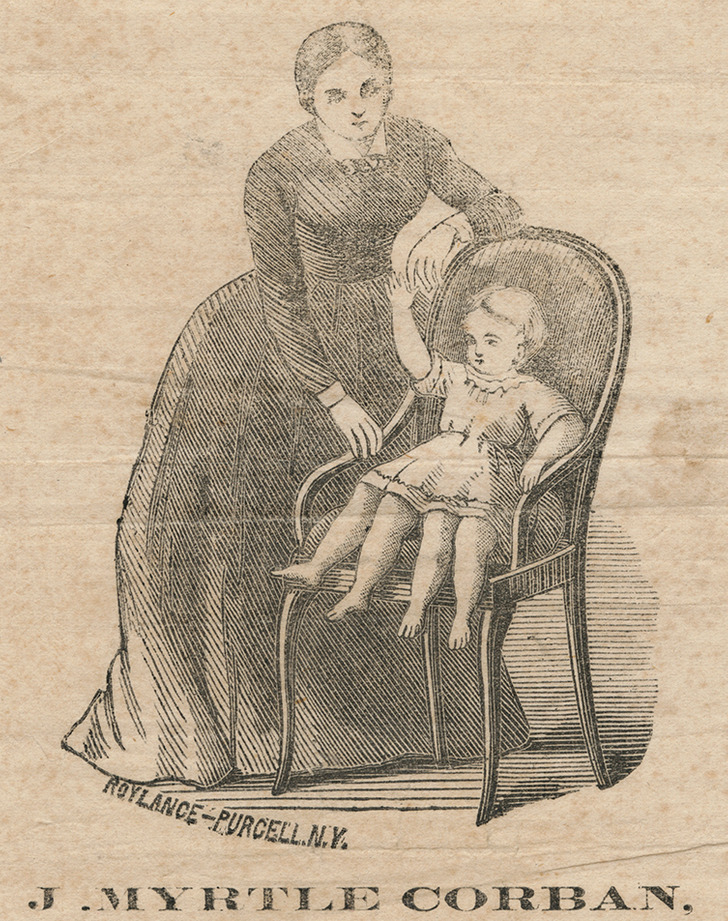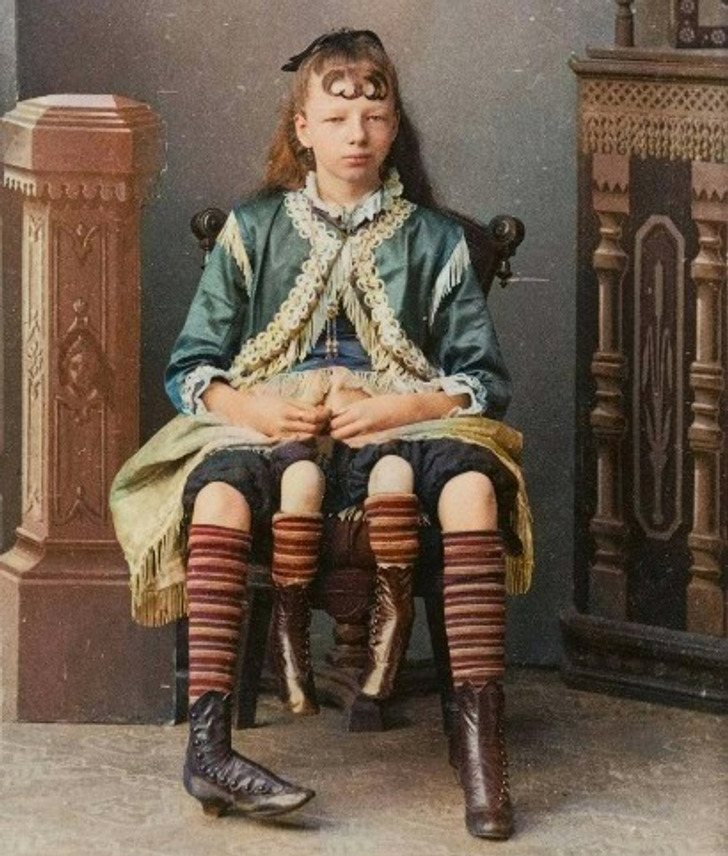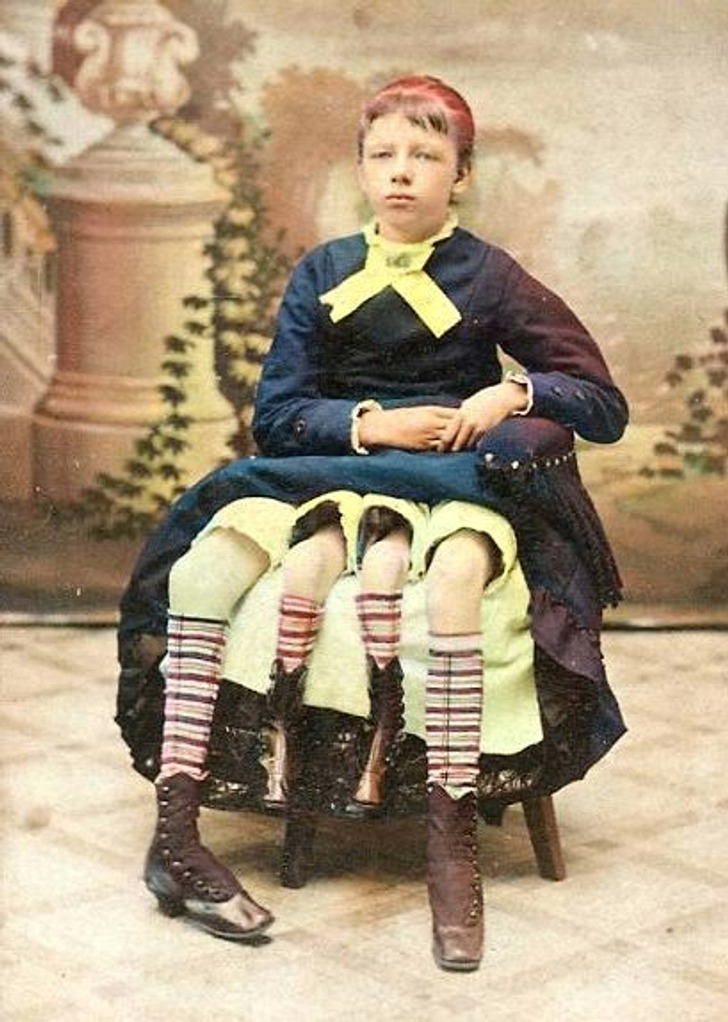Josephine Myrtle Corbin was born with a rare birth defect called polymelia, meaning born with extra limbs, in her case, she had 4 legs, 2 normal ones and 2 smaller ones that grew from her hips. But there was more to it. She also had 2 sets of reproductive organs and 2 pelvises. Because of this rare occurrence, she’s probably one of the few people in history considered wonders. Let’s delve into Myrtle’s story and discover her exceptional life milestones.Myrtle was considered a rare and remarkable case of human development.
Josephine Myrtle Corbin, an American sideshow performer, came into the world in 1868 as a remarkable medical rarity. Affected by a condition known as dipygus, she possessed two lower bodies from the waist down. This unusual phenomenon occurred due to her body axis splitting during development, resulting in two separate pelvises side by side. Remarkably, her smaller inner legs were paired with one of her outer legs. While Myrtle could move her inner legs, but they were too weak to walk on.
Born in Tennessee to her parents, William and Nancy, Myrtle’s arrival brought both wonder and concern. At 25, her father, William, and 34-year-old mother, Nancy, welcomed the unique little Myrtle into their lives. Medical professionals noted that if Myrtle had been delivered breech, with her bottom first, it could have been potentially fatal for both her and her mother. Thankfully, Myrtle’s early days were promising, as she displayed signs of strength, weighing 10 lb (4.5kg) just 3 weeks after her birth.
Myrtle’s father was facing financial hardship and had to think of ways to support his growing family.

© Charles Eisenmann (1855-1927) / Wikimedia Commons, © Public domain, © Palette.fm
At the age of 5 weeks, people had the opportunity to visit William Corbin and marvel at his four-legged daughter for a small fee. As the years passed, Myrtle grew up accustomed to the constant stares and astonishment from those who encountered her rare condition. Her inner legs never fully developed, her right foot was clubbed, and both of the smaller legs had 3 toes on each foot.
Over the following decade, William took Myrtle on a journey across the country, where she participated in fairs, sideshows, and dime museums. By the time she turned 14, she had achieved success and managed to secure a lucrative contract paying her an unusually high salary of $250 per week.
The four-legged girl, Myrtle, had a younger sister named Ann, who fortunately did not suffer from any birth defects.
Myrtle married when she was 18 and later became a mother.

© James R. Applegate (1849–1910), Philadelphia / Wikimedia Commons, © Public Domain, © Palette.fm
As Myrtle entered adulthood, she grew weary of the constant attention she received due to her condition. At 18, she decided to marry James Bicknell, a medical student, after which she retired from her performing career. Interestingly, her fame had inspired others to attempt to fake her unique deformity, but all of these impostors were eventually exposed as frauds.
A year into their marriage, Myrtle experienced troubling symptoms like fever, nausea, headaches, and side pains. Concerned, she sought medical attention, and to her disbelief, the doctor revealed that she was pregnant on her left side. Myrtle skeptically responded, saying, “If it had been on my right side, I would come nearer believing you are correct.” The pregnancy proved challenging for her health, and doctors even advised her to consider an abortion due to the severity of her illness. However, Myrtle managed to recover swiftly.
Over the following years, James and Myrtle welcomed seven more children into their family. Tragically, only 5 of them survived infancy, 4 daughters and a son.
© Unknown author / Wikimedia Commons, © Public Domain
The family lived a quiet life until their 5 children reached adulthood. Then Myrtle re-entered the show business. In 1909, when Myrtle was 41, she was a part of Huber’s Museum exhibit, appearing as The Four-Legged Girl from Cleburne, Texas. She often dressed her 4 legs in matching shoes and socks, to the audience’s delight. She was making $450 per week at the time.
In 1928, Myrtle developed a skin infection on her right leg, and the doctor diagnosed her with erysipelas or a strep infection. A week later, on May 6th, 1928, Myrtle passed away. Her casket was covered in concrete, and family members kept watch until it was fully cured to prevent grave robbers from stealing her remains.
Almost a century later, Josephine Myrtle Corbin Bicknell continues to inspire others by proving that even in the 19th century, a woman could forge a successful career and become a mother all at once.
From the ‘Bundy Bounce’ to Household Mayhem: Unraveling the Comedic Genius of a 90s TV Classic
In the annals of classic television sitcoms, few moments have become as iconic and enduring as the “Bundy Bounce.” First introduced in a 1990s episode of the beloved series “Married… with Children,” this outrageous dance move, invented by the show’s resident fashionista Kelly Bundy, has lived on in the memories of fans for decades.
At the heart of this memorable sequence is a classic tale of sibling rivalry, as Kelly’s attempt to impress at a car audition is complicated by the meddling of her brother, Bud. But beyond the central plotline, this episode also delves into the Bundy family’s signature brand of chaotic humor, as the family matriarch, Peg, refuses to do any household chores, much to the dismay of her long-suffering husband, Al.
The episode opens with Kelly, the quintessential Bundy daughter, determined to land the coveted role of spokesperson for the new Allanté car. Recognizing that she needs to stand out from the competition, Kelly hatches a plan to wow the executives with a unique dance move that she dubs “The Bundy Bounce.”

“The Bundy Bounce” is a dynamic, high-energy routine that showcases Kelly’s confidence, sass, and flair for the dramatic. With its exaggerated hip movements and playful, almost mocking tone, the dance perfectly encapsulates Kelly’s larger-than-life personality and her unwavering desire to be the center of attention.
As Kelly prepares to unveil her showstopping routine at the audition, her brother Bud, ever the opportunist, decides to exploit his sister’s ambition for his own gain. Revealing Kelly’s dance to a rival contestant, Bud sets the stage for a dramatic showdown, with the fate of the Allanté spokesperson gig hanging in the balance.
The rivalry between Kelly and Bud has long been a source of humor and drama within the Bundy household, and this episode is no exception. As the two siblings vie for the spotlight, their animosity towards one another comes to a head, with each determined to outmaneuver the other.
Bud’s decision to share Kelly’s dance move with her competition not only jeopardizes Kelly’s chances at landing the job but also showcases the lengths the Bundy children will go to in order to one-up each other. This sibling dynamic is a crucial element of the show’s enduring appeal, as it taps into the universal experiences of family life and the push-and-pull of brotherly and sisterly relationships.
While the “Bundy Bounce” storyline takes center stage, the episode also features a hilarious subplot involving the family matriarch, Peg Bundy. Fed up with the constant demands of maintaining the household, Peg decides to go on a household strike, refusing to do any chores or cooking.
This decision sends the Bundy household into a tailspin, as Al, the family patriarch, is forced to confront just how dependent he is on Peg’s domestic labor. The resulting chaos, with dirty dishes piling up and the family left to fend for themselves, is a prime example of the show’s signature brand of over-the-top, slapstick humor.
In the decades since its original airing, the “Bundy Bounce” episode has cemented its place as a beloved classic within the “Married… with Children” canon. The iconic dance move, with its catchy rhythm and Kelly’s unforgettable performance, has become a touchstone for fans of the show, a moment that perfectly encapsulates the series’ irreverent spirit and the Bundy family’s unique brand of chaos.
Beyond the “Bundy Bounce” itself, the episode’s exploration of the family’s complex dynamics and its blend of humor, drama, and memorable characters have all contributed to its enduring legacy. As new generations discover the show, this episode continues to captivate and entertain, solidifying “Married… with Children” as a true sitcom masterpiece.
In the annals of classic television comedy, the “Bundy Bounce” episode of “Married… with Children” stands out as a shining example of the show’s ability to blend memorable characters, iconic moments, and relatable family dynamics into a truly engaging and entertaining whole. From Kelly’s showstopping dance moves to the Bundy household’s descent into domestic disarray, this episode is a testament to the series’ enduring appeal and its status as a beloved, genre-defining sitcom.
As fans continue to revisit this classic episode, the “Bundy Bounce” and the stories it encompasses will undoubtedly continue to captivate and entertain, cementing its place as a cornerstone of television history and a testament to the enduring power of the Bundy family’s unique brand of chaos.



Leave a Reply